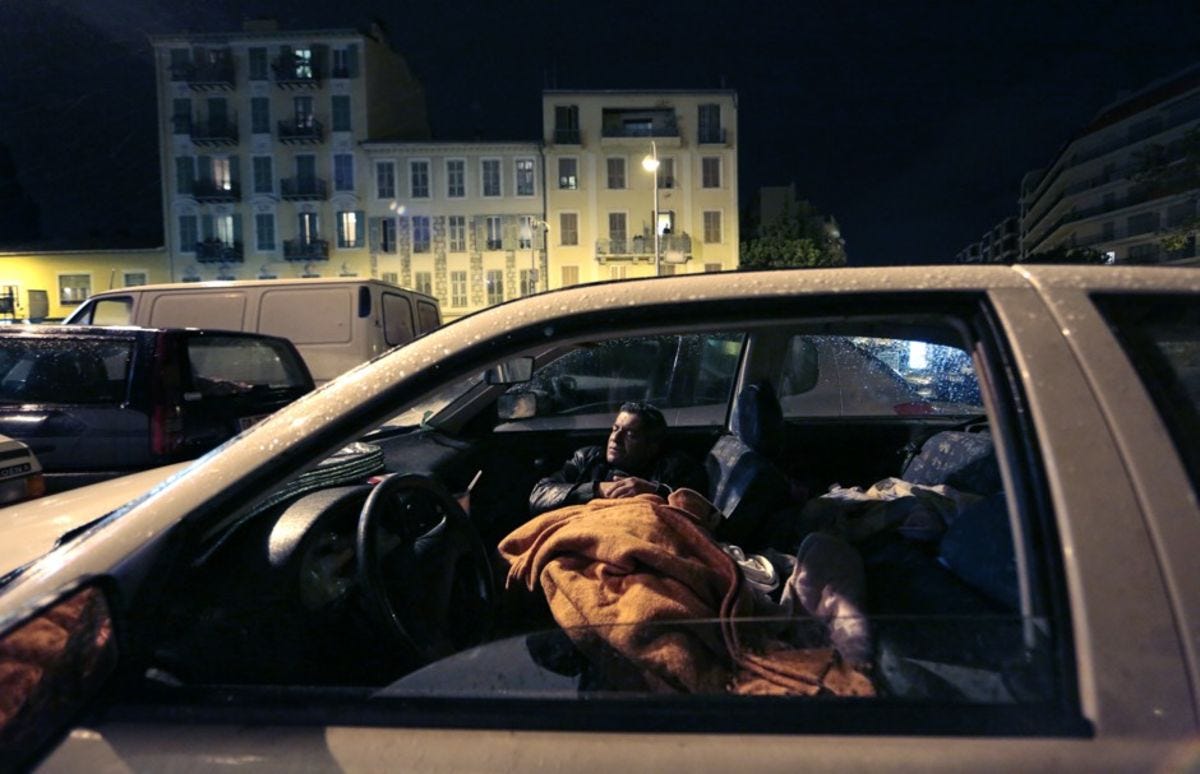We Need a Transitional Urbanism
Who do we mean when we say we "build cities for people, not cars"?
I met a man this morning. For the sake of his privacy, we’ll call him John.
John frequents the Starbucks where I meet a few men for bible study on Tuesday mornings. He grabs a coffee, charges his phone, and joyfully says hello to anyone and everyone that walks by. Listening to the greetings makes the early-morning hours of a Kroger Starbucks sitting area a delightful place to be.
John had a long and successful career in phone sales, is a member of a church down the street, and is considering moving in with his son’s family if they get a place by the ocean. But right now, he lives in his car, and in his words, “couldn’t be more grateful for the life (he has).”
I don’t know the full set of circumstances that led John to his current living situation. But after 25 minutes of conversation this morning, I know I hope to see him again next week. And I know he’s the kind of guy I’d love to have as a neighbor.
I was thinking about that on the way home today. And I realized most urbanism discourse lacks much of a category for people like John. After all, his home is the one thing many urbanists hate more than anything else.
We may have ideals for John - something about “building more mixed-use places that create more affordable housing stock so John doesn’t have to live in his car.”
And that’s great. We should do that. But in most places, where wins are incremental and true naturally occurring affordable housing (NOAH) is years or decades away, what do we do for people like John?
To be at our most effective, and to avoid a utilitarian urbanism that discounts “inconvenient people,” I think we need to separate our vision into two categories:
Aspirational urbanism and transitional urbanism.
The former is the one you primarily see in online discourse: mixed-use development renderings; pristine, separated, protected bike lanes and sidewalks; roundabouts so perfect that Yes would be proud.
And we should aspire to those things.
But in the meantime, we need to recognize the gaping chasm that exists between where most places currently are and where we want them to be. And that change often has a way of leaving people behind.
This is because as we aim for the ideal, we often get in a mindset of “refusing to settle,” but those most affected by our cities’ current lack of sidewalks, transit, and housing see years of their lives go by, bills pile up, and solutions to their problems nowhere in sight.
A transitional urbanism addresses this head-on by learning how to juggle.
On the one hand, it continues to use the goals of aspirational urbanism as a north star. But on the other, it is formed by hospitality and care for neighbor: plastic bollards as temporary cyclist protection; tiny home villages that provide shelter for the homeless; even safe parking for those who live in their cars.
And transitional urbanism makes these situations possible by seeing them as momentum towards something greater, not as something chosen in lieu of permanent, better, more sustainable solutions and victories.
It remembers people like my new friend John.
“Building places for people, not cars” is a common rallying cry of the online urbanist. But we often focus more on digging into the “not cars” part than on asking which people we’re building for and what will be required of us to build for them.
If we mean what we say, and “building places for people” truly is the heart of what we’re about, we should make sure our vision and ideology has space to bring everybody along with us as we build better places. Otherwise, what’s the point?
One Thing to Get Excited About:
Research in Edinburgh has reconfirmed what we’ve known for a long time: slowing cars reduces traffic deaths.
Specifically, the research found that reducing speeds in Edinburgh to 20mph reduced road deaths by nearly a quarter, and serious injuries by nearly a third.


One Action to Get You Started :
Ask who is being left on the outside looking in on the positive changes happening in your town.
Take some time this week intentionally trying to notice those who usually go unnoticed. Proactively put them at the forefront of your problem-solving, and begin determining what it would look like to put forth solutions that make space for them in your city.
One Resource to Check Out:
It’s not a new project, but Madrid, Spain, is in the process of building a green wall around its city to help improve air quality. The World Economic Forum has a short, helpful explainer video about the project below:





